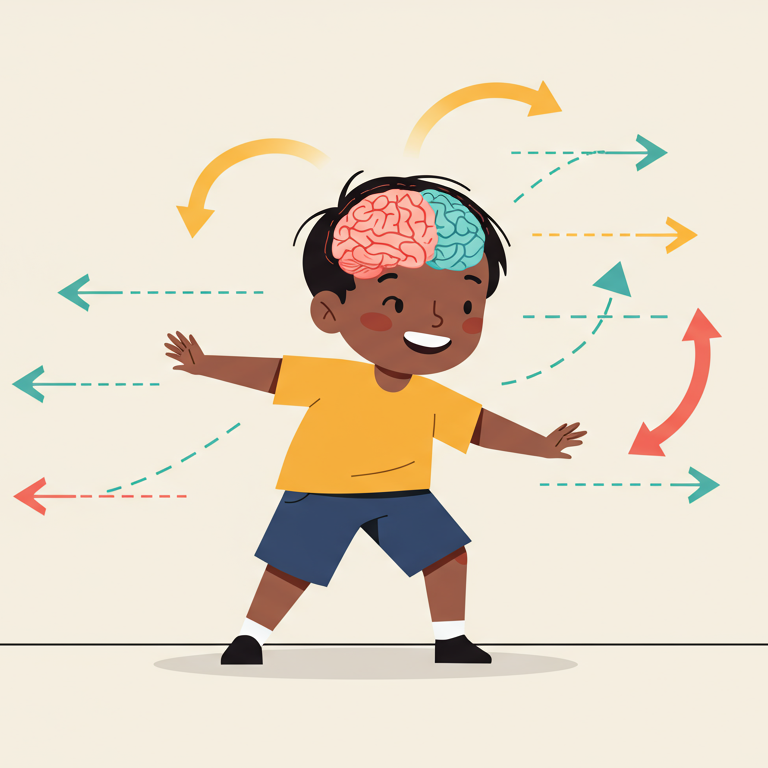What is Brain and Body Communication?

Overview
Your child's body communicates what their brain is processing—through movement, stillness, and physical responses. Learn to read these signals instead of managing behavior.
What Is Brain and Body Communication?
Your child who can recite entire movie scripts suddenly can't answer "how was your day?" The kid who organizes their stuffed animals by size loses it when you ask them to find their shoes. They navigate complex social dynamics at recess but freeze when the teacher calls on them directly.
These aren't contradictions. They're your child's nervous system prioritizing different demands in different contexts.
Brain and body communication is the ongoing negotiation between what your child's senses take in, how their brain interprets that information, and what their body does in response. Every shift in tone, every need for movement, every moment of stillness—these are your child's systems talking.
When we only respond to the visible action (the yelling, the running, the refusal), we miss what their nervous system is managing underneath.
Why We Learned to Watch Behavior Instead of Bodies
We were taught that behavior is something to shape, correct, or reward. The focus was always on the action itself—what the child did—not what their body was trying to regulate.
But bodies don't misbehave. They respond to neurological and sensory information, often before conscious thought kicks in. That "attitude" after school isn't defiance—it's nervous system overflow released in a safe space. The constant movement during homework isn't distraction—it's how their brain maintains focus.
Watch how your child's body responds, not just what they do. Patterns emerge.
How the Conversation Works
The nervous system takes in sensory information—sound, light, touch, movement, social energy. The brain processes whether this feels manageable or overwhelming. The body responds automatically: seeking more input, avoiding stimulation, or shutting down to protect the system.
This loop runs constantly, mostly outside conscious awareness. Your child isn't deciding to bounce during dinner or go nonverbal after a playdate. Their body is doing what it needs to maintain regulation.
The body knows first. While your child searches for words, their nervous system has already responded. Movement calms. Withdrawal protects. Rigidity manages uncertainty.
What to Notice
Watch for shifts in your child's physical state across different contexts:
Energy regulation: When does their body speed up? When does it slow down or collapse? What happens right before these shifts?
Environmental responses: Which settings make their body visibly tense? Where do you see their shoulders drop and their voice relax?
Transition patterns: How does their body handle the shift from one activity to another? Do they need movement between tasks or time to sit quietly first?
Track these patterns over a few days. You'll start recognizing which situations demand more from their system and which allow recovery.
What This Changes
Understanding brain and body communication doesn't eliminate difficult moments. It shifts your role.
Instead of managing behavior, you're supporting regulation. Instead of asking "why won't they just..." you're asking "what is their body trying to manage right now?" Instead of seeing inconsistency, you're recognizing that different contexts make different demands on the same nervous system.
Your child isn't unpredictable. Their brain and body are constantly adapting to what the environment requires.
What Brain and Body Communication Is Not
This framework isn't permission for unsafe behavior or the removal of boundaries. It's not saying every response is acceptable or that structure doesn't matter.
Before you can support different behavior, you need to understand what's driving the current response. Boundaries work when they match what a child's nervous system can handle.
Key Takeaways
- Behavior is your child's body expressing what their brain is processing
- The nervous system responds to sensory and emotional information before conscious thought
- Different contexts make different regulatory demands on the same child
- Observing physical patterns reveals what supports or overwhelms your child's system
- Understanding the signal changes how you respond to the action
Want to see how this plays out across five interconnected systems?
